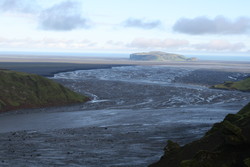Glacier-outburst flood from Mýrdalsjökull
The jökulhlaup (glacier-outburst flood) which came from Mýrdalsjökull early morning Saturday 9th July, and swept away a bridge over Múlakvísl, came from four ice cauldrons in southeastern part of the Katla volcano (caldera); three of them well-known. Some weeks before, microseismicity had been registrered near several ice cauldrons in the caldera and a flood tremor was monitored during the flood.
The Mýrdalsjökull flood monitoring system operates with two gauging stations for the glacier river Múlakvísl. The main indicator, located on the bridge on the main road Þjóðvegur 1, began to show increased conduction early evening on 8th July, around the time of peak in the tremor. The water level reached the bridge around midnight, causing damage to the sensors. Contact to the instruments was lost a few hours later.
Another gauging station is at Selfjall, ment for registration of flood heights as well as a part of the warning system. It is normally not in the water. Around 4 am 9th July, it began to show rising water level, and within minutes the water level rose by more than 5 meters. Experience has shown that when the flood peaks at Selfjall it reaches the main road in about an hour, and may have swept the bridge away around 5 am.
The harmonic tremor registered prior to the flood continued, but diminished significantly on Saturday.




